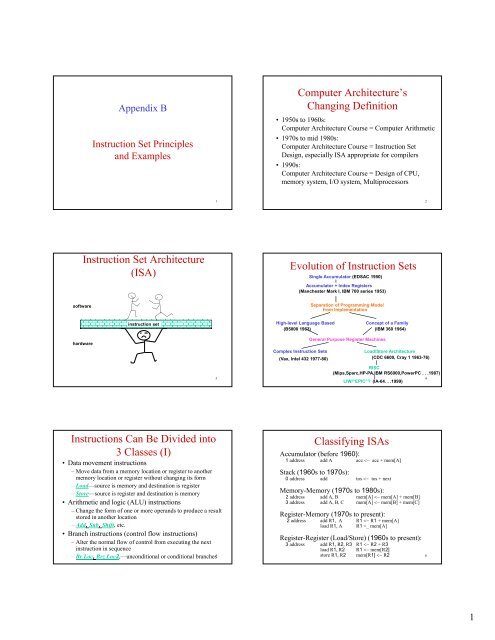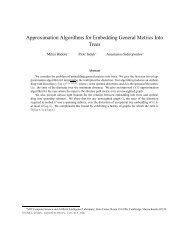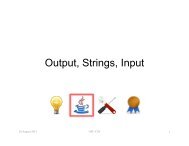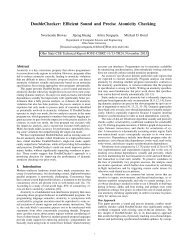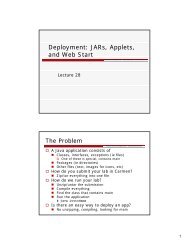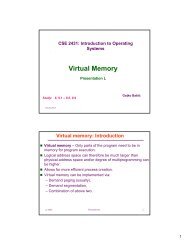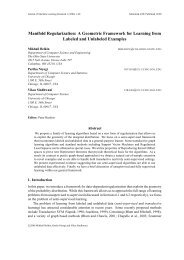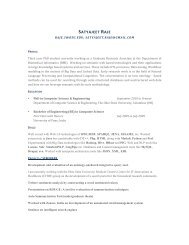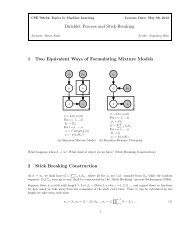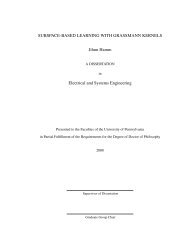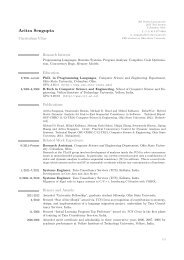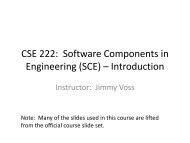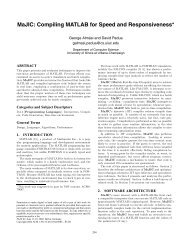Computer Architecture's Changing Definition Instruction Set ...
Computer Architecture's Changing Definition Instruction Set ...
Computer Architecture's Changing Definition Instruction Set ...
Create successful ePaper yourself
Turn your PDF publications into a flip-book with our unique Google optimized e-Paper software.
software<br />
Appendix B<br />
<strong>Instruction</strong> <strong>Set</strong> Principles<br />
and Examples<br />
<strong>Instruction</strong> <strong>Set</strong> Architecture<br />
(ISA)<br />
hardware<br />
instruction set<br />
<strong>Instruction</strong>s Can Be Divided into<br />
3 Classes (I)<br />
• Data movement instructions<br />
– Move data from a memory location or register to another<br />
memory location or register without changing its form<br />
– Load—source is memory and destination is register<br />
– Store—source is register and destination is memory<br />
• Arithmetic and logic (ALU) instructions<br />
– Change the form of one or more operands to produce a result<br />
stored in another location<br />
– Add, Sub, Shift, etc.<br />
• Branch instructions (control flow instructions)<br />
– Alter the normal flow of control from executing the next<br />
instruction in sequence<br />
– Br Loc, Brz Loc2,—unconditional or conditional branches 5<br />
1<br />
3<br />
<strong>Computer</strong> Architecture’s<br />
<strong>Changing</strong> <strong>Definition</strong><br />
• 1950s to 1960s:<br />
<strong>Computer</strong> Architecture Course = <strong>Computer</strong> Arithmetic<br />
• 1970s to mid 1980s:<br />
<strong>Computer</strong> Architecture Course = <strong>Instruction</strong> <strong>Set</strong><br />
Design, especially ISA appropriate for compilers<br />
• 1990s:<br />
<strong>Computer</strong> Architecture Course = Design of CPU,<br />
memory system, I/O system, Multiprocessors<br />
Evolution of <strong>Instruction</strong> <strong>Set</strong>s<br />
Single Accumulator (EDSAC 1950)<br />
Accumulator + Index Registers<br />
(Manchester Mark I, IBM 700 series 1953)<br />
Separation of Programming Model<br />
from Implementation<br />
High-level Language Based Concept of a Family<br />
(B5000 1963) (IBM 360 1964)<br />
General Purpose Register Machines<br />
Complex <strong>Instruction</strong> <strong>Set</strong>s Load/Store Architecture<br />
(Vax, Intel 432 1977-80)<br />
(CDC 6600, Cray 1 1963-76)<br />
RISC<br />
(Mips,Sparc,HP-PA,IBM RS6000,PowerPC . . .1987)<br />
4<br />
LIW/”EPIC”? (IA-64. . .1999)<br />
Classifying ISAs<br />
Accumulator (before 1960):<br />
1 address add A acc
Classifying ISAs<br />
Load-Store:<br />
Pros and Cons<br />
• Pros<br />
– Simple, fixed length instruction encoding<br />
– <strong>Instruction</strong>s take similar number of cycles<br />
– RRelatively l ti l easy to t pipeline i li<br />
• Cons<br />
– Higher instruction count<br />
– Not all instructions need three operands<br />
– Dependent on good compiler<br />
General Register Machine and<br />
<strong>Instruction</strong> Formats<br />
Memory<br />
Op1Addr: Op1<br />
load<br />
CPU<br />
Registers<br />
Nexti Program<br />
counter<br />
R8<br />
R6<br />
R4<br />
R2<br />
<strong>Instruction</strong> formats<br />
load R 8, Op1 (R 8
Real Machines Are Not So<br />
Simple<br />
• Most real machines have a mixture of 3, 2, 1, 0,<br />
and 1- address instructions<br />
• A distinction can be made on whether arithmetic<br />
instructions use data from memory<br />
• If ALU instructions only use registers for<br />
operands and result, machine type is load-store<br />
– Only load and store instructions reference memory<br />
• Other machines have a mix of register-memory<br />
and memory-memory instructions<br />
Types of Addressing Modes<br />
(VAX)<br />
1.Register direct Ri<br />
2.Immediate (literal) #n<br />
3.Displacement M[Ri + #n]<br />
4.Register indirect M[Ri]<br />
55.Indexed Indexed M[Ri + Rj]<br />
6.Direct (absolute) M[#n]<br />
reg. file<br />
7.Memory IndirectM[M[Ri] ]<br />
8.Autoincrement M[Ri++]<br />
9.Autodecrement M[Ri - -]<br />
10. Scaled M[Ri + Rj*d + #n]<br />
Distribution of Displacement<br />
Values<br />
13<br />
memory<br />
15<br />
17<br />
Alignment Issues<br />
• If the architecture does not restrict memory accesses to be<br />
aligned then<br />
– Software is simple<br />
– Hardware must detect misalignment and make 2 memory accesses<br />
– Expensive detection logic is required<br />
– All references can be made slower<br />
• Sometimes unrestricted alignment is required for backwards<br />
compatibility<br />
• If the architecture restricts memory accesses to be aligned then<br />
– Software must guarantee alignment<br />
– Hardware detects misalignment access and traps<br />
– No extra time is spent when data is aligned<br />
• Since we want to make the common case fast, having restricted<br />
alignment is often a better choice, unless compatibility is an<br />
issue<br />
Summary of Use of Addressing<br />
Modes<br />
Frequency of Immediate<br />
Operands<br />
14<br />
16<br />
18<br />
3
Types of Operations<br />
• Arithmetic and Logic: AND, ADD<br />
• Data Transfer: MOVE, LOAD, STORE<br />
• Control BRANCH, , JUMP, , CALL<br />
• System OS CALL, VM<br />
• Floating Point ADDF, MULF, DIVF<br />
• Decimal ADDD, CONVERT<br />
• String MOVE, COMPARE<br />
• Graphics (DE)COMPRESS<br />
9<br />
80x86 <strong>Instruction</strong> Frequency<br />
(SPECint92, Fig. B.13)<br />
Rank <strong>Instruction</strong> Frequency<br />
1 load 22%<br />
2 branch 20%<br />
3 compare 16%<br />
4 store 12%<br />
5 add 8%<br />
6 and 6%<br />
7 sub 5%<br />
8 register move 4%<br />
9 call 1%<br />
10 return 1%<br />
Total 96%<br />
Control instructions (cont’d)<br />
• Addressing modes<br />
– PC-relative addressing (independent of program load<br />
& displacements are close by)<br />
• RRequires i displacement di l t (how (h many bits?) bit ?)<br />
• Determined via empirical study. [8-16 works!]<br />
– For procedure returns/indirect jumps/kernel traps, target<br />
may not be known at compile time.<br />
• Jump based on contents of register<br />
• Useful for switch/(virtual) functions/function ptrs/dynamically<br />
linked libraries etc.<br />
19<br />
21<br />
23<br />
Distribution of Data Accesses<br />
by Size<br />
Relative Frequency of<br />
Control <strong>Instruction</strong>s<br />
Branch Distances (in terms of<br />
number of instructions)<br />
20<br />
22<br />
24<br />
4
Frequency of Different Types of<br />
Compares in Conditional<br />
Branches<br />
Three choice for encoding the<br />
instruction set<br />
Compilers Phases<br />
25<br />
27<br />
29<br />
Encoding an <strong>Instruction</strong> set<br />
• a desire to have as many registers and<br />
addressing mode as possible<br />
•the impact p of size of register g and addressing g<br />
mode fields on the average instruction size<br />
and hence on the average program size<br />
• a desire to have instruction encode into<br />
lengths that will be easy to handle in the<br />
implementation<br />
Compilers and ISA<br />
• Compiler Goals<br />
– All correct programs compile correctly<br />
– Most compiled programs execute quickly<br />
– Most programs compile quickly<br />
– Achieve small code size<br />
– Provide debugging support<br />
• Multiple Source Compilers<br />
– Same compiler can compiler different languages<br />
• Multiple Target Compilers<br />
– Same compiler can generate code for different<br />
machines<br />
28<br />
Compiler Based Register<br />
Optimization<br />
• Assume small number of registers (16-32)<br />
• Optimizing use is up to compiler<br />
• HLL programs have no explicit references to registers<br />
– usually – is this always true?<br />
• Assign symbolic or virtual register to each candidate<br />
variable<br />
• Map (unlimited) symbolic registers to real registers<br />
• Symbolic registers that do not overlap can share real<br />
registers<br />
• If you run out of real registers some variables use memory<br />
• Uses graph coloring approach<br />
26<br />
30<br />
5
Designing ISA to Improve<br />
Compilation<br />
• Provide enough general purpose registers to ease<br />
register allocation ( more than 16).<br />
• Provide regular instruction sets by keeping the<br />
operations, data types, and addressing modes<br />
orthogonal.<br />
• Provide primitive constructs rather than trying to<br />
map to a high-level language.<br />
• Simplify trade-off among alternatives.<br />
• Allow compilers to help make the common case<br />
fast.<br />
31<br />
Main Processor<br />
Registers<br />
$0<br />
$ 3 1<br />
A rithm e tic Multiply<br />
Logic unit<br />
divide<br />
Prog. Counter<br />
MIPS Processor<br />
Mem ory<br />
Lo Hi<br />
Coprocessor1 (FPU)<br />
Registers<br />
$0<br />
Coprocessor0 (trapsand memory)<br />
Registers<br />
Ba d VAddr<br />
Cause<br />
Status<br />
EPC<br />
$ 3 1<br />
A r ith m e tic<br />
unit<br />
MIPS Registers (continued)<br />
• Coprocessor 0 (CP0) registers (partial list):<br />
– Status register (CP0reg12) – processor status and control;<br />
– Cause register (CP0reg13) – cause of the most recent<br />
exception;<br />
–EPC register(CP0reg14) – program counter at the last<br />
exception;<br />
– BdVAdd BadVAddr register it (CP0 (CP0reg08) 08) – th the address dd for f the th mostt<br />
recent address related exception;<br />
– Count register (CP0reg09) – acts as a timer, incrementing<br />
at a constant rate that is a function of the pipeline clock;<br />
– Compare register (CP0reg11) – used in conjunction with<br />
Count register;<br />
– Performance Counter register (CP0reg25);<br />
Control<br />
33<br />
35<br />
ISA Metrics<br />
• Orthogonality<br />
– No special registers, few special cases, all operand<br />
modes available with any data type or instruction type<br />
• Completeness<br />
– Support for a wide range of operations and target<br />
applications<br />
• Regularity<br />
– No overloading for the meanings of instruction fields<br />
• Streamlined Design<br />
– Resource needs easily determined. Simplify tradeoffs.<br />
• Ease of compilation (programming?), Ease of<br />
implementation, Scalability<br />
MIPS Registers<br />
• Main Processor (integer manipulations):<br />
– 32 64-bit general purpose registers – GPRs (R0 –R31); R0 has fixed value of zero. Attempt to writing into R0 is not<br />
illegal, but its value will not change;<br />
– two 64-bit registers – Hi & Lo, hold results of integer<br />
multiply and divide<br />
– 64-bit program p g counter – PC; ;<br />
• Coprocessor 1 (Floating Point Processor ─ real numbers<br />
manipulations):<br />
– 32 64-bit floating point registers – FPRs (f0 – f31); – five control registers;<br />
• Coprocessor 0 – CP0 is incorporated on the MIPS CPU chip<br />
and it provides functions necessary to support operating<br />
system: exception handling, memory management scheduling<br />
and control of critical resources.<br />
MIPS Data Types<br />
• MIPS64 operates on:<br />
– 64-bit (unsigned or 2’s complement) integers,<br />
– 32-bit (single precision floating point) real numbers,<br />
– 64-bit (double precision floating point) real numbers;<br />
• 8-bit bytes, bytes 16-bit half words and 32-bit words loaded into<br />
GPRs are either zero or sign bit expanded to fill the 64 bits.<br />
• only 32- or 64-bit real numbers can be loaded into FPRs.<br />
• 32-bit real number loaded into FPRs is zero-appended.<br />
32<br />
34<br />
36<br />
6
MIPS Addressing Modes<br />
• register addressing;<br />
• immediate addressing;<br />
• register indexed is the only memory data addressing;<br />
(in MIPS terminology called base addressing):<br />
– memory address = register content plus 16-bit offset<br />
• since R0 always contains value 0:<br />
–R0 + 16–bit offset � absolute addressing;<br />
– 16-bit offset = 0 � register indirect;<br />
• branch instructions use PC relative addressing:<br />
– branch address = [PC] + 4 + 4×16-bit offset<br />
• jump instructions use:<br />
– pseudo-direct addressing with 28-bit addresses (jumps<br />
inside 256MB regions),<br />
– direct (absolute) addressing with 64-bit addresses.<br />
MIPS Alignment<br />
• MIPS supports byte addressability:<br />
– it means that a byte is the smallest unit with its own address;<br />
• MIPS restricts memory accesses to be aligned as follows:<br />
– 64-bit word has to start at byte address which is multiple of 8;<br />
thus, 64-bit word at address 8x includes eight bytes with<br />
addresses 8x, 8x+1, 8x+2, … 8x+6, 8x+7.<br />
– 32-bit word has to start at byte y address that is multiple p of 4; ;<br />
thus, 32-bit word at address 4n includes four bytes with<br />
addresses: 4n, 4n+1, 4n+2, and 4n+3.<br />
– 16-bit half word has to start at byte address that is multiple<br />
of 2; thus, 16-bit word at address 2n includes two bytes with<br />
addresses: 2n and 2n+1.<br />
• MIPS supports 64-bit addresses:<br />
– it means that an address is given as 64-bit unsigned integer;<br />
Figure B.23<br />
Load/Store <strong>Instruction</strong>s<br />
37<br />
39<br />
41<br />
<strong>Instruction</strong> Layout for MIPS<br />
MIPS <strong>Instruction</strong><br />
• <strong>Instruction</strong>s that move data:<br />
– load to register from memory (only base addressing),<br />
– store from register to memory (only base addressing),<br />
– move between registers in same and different coprocessors.<br />
• ALU integer instructions; register – register and registerimmediate<br />
computational p instructions.<br />
• Floating point instructions; register – register computational<br />
instructions and floating point to/from integer conversions.<br />
• Control-related instruction:<br />
– (simple) branch instructions use PC relative addressing<br />
– jump instructions with 28-bit addresses (jumps inside<br />
256MB regions), or absolute 64-bit addresses.<br />
• Special control-related instructions.<br />
Figure B.24<br />
Sample ALU <strong>Instruction</strong>s<br />
38<br />
40<br />
42<br />
7
Figure B.25<br />
Control Flow <strong>Instruction</strong>s<br />
43 Figure B.26 44<br />
8


